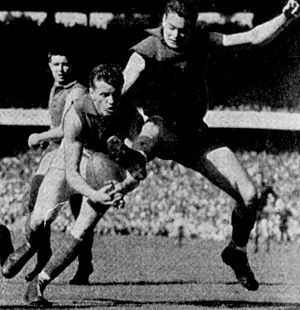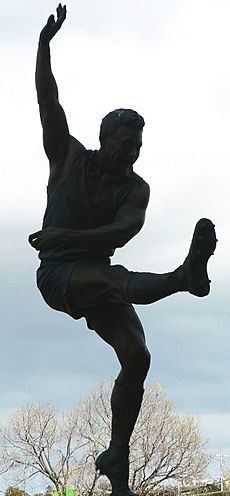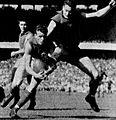Ron Barassi facts for kids
Quick facts for kids Ron BarassiAM |
|||
|---|---|---|---|

Sculpture of Barassi in Guildford, Victoria
|
|||
| Personal information | |||
| Date of birth | 27 February 1936 | ||
| Place of birth | Castlemaine, Victoria, Australia | ||
| Date of death | 16 September 2023 (aged 87) | ||
| Place of death | Melbourne, Victoria, Australia | ||
| Original team | Preston Scouts | ||
| Position(s) | Midfielder | ||
| Career highlights | |||
|
Club
Representative
Overall
Coaching
|
|||
Ronald Dale Barassi AM (born 27 February 1936 – died 16 September 2023) was an amazing Australian rules footballer, coach, and media star. Many people think he was one of the greatest and most important people in the history of the game.
Ron Barassi was the very first player to be named a "Legend" in the Australian Football Hall of Fame. He is also one of only four Australian rules footballers to get the same special status in the Sport Australia Hall of Fame.
When Ron was five years old, his dad, who also played for the Melbourne Football Club, sadly died during World War II. Ron was determined to play for Melbourne, just like his father. The club worked hard to get him, which led to a new rule called the father–son rule. This rule is still used in the AFL today!
Ron then lived with Norm Smith, who was Melbourne's coach and his father's old teammate. Norm helped Ron become a great player. Ron helped create a new playing style called the "ruck rover". He played in six teams that won the premiership, and he was captain for two of those wins.
In 1964, Ron made a big move to the Carlton team. He stopped playing in 1969 but continued as a coach. He led Carlton to two premierships, including an amazing comeback win in the 1970 Grand Final. This game is famous for his half-time speech, which helped change how modern football was played.
Ron stopped coaching in 1971 but returned two years later to coach North Melbourne. He led them to their first two premierships. Later, he went back to coach Melbourne and started the "Irish experiment". This involved bringing Gaelic footballers from Ireland to play Australian rules. He also coached the Sydney Swans. Ron's coaching helped these clubs become strong again.
Ron Barassi's coaching was very successful and changed the game. He was always fair and loved the sport. He worked hard to create a national football competition. Because of his passion, he became a famous person in Australia. He was named a Member of the Order of Australia in 1978. In 1996, he was chosen for the AFL's Australian Football League#Team of the Century as a ruck-rover.
Ron Barassi passed away on 16 September 2023.
Contents
Early Life and Family History
Ron Barassi was born in Castlemaine, Victoria, in 1936. He was the only child of Ron Barassi, Sr.. The next year, his father moved to Melbourne to play VFL football for the Melbourne Football Club. Ron's father was a strong player who was part of the Demons' 1940 premiership team. He then left to serve in the army during World War II. Young Ron spent his early years in Guildford, Victoria.
Ron Barassi's family came from Swiss Italian ancestors. They moved to Victoria during the gold rushes in the 1850s and 1860s. They settled in areas like Guildford, Castlemaine, and Daylesford.
Ron Barassi's Football Journey
Ron Barassi changed the game even before he played his first match. After his father died in 1941, players and officials from the Melbourne Football Club promised to help his mother and young son. As a teenager, Ron really wanted to play for the Demons, just like his dad. However, the rules at the time meant he should play for either Collingwood or Carlton.
The Father–Son Rule
To make sure Ron could play for Melbourne, the club asked the VFL to create a special rule. This rule, called the father–son rule, allows clubs to recruit sons of players who have played many games for the team (at least 50 games when the rule started).
Melbourne chose Ron from Preston Scouts in 1952. He was only the second player ever signed under this new rule. This rule, with some changes, is still used in the AFL today!
The club worked very hard to get Ron. Coach Norm Smith took Ron under his wing after Ron's mother moved away. Norm offered the 16-year-old a place to live. Ron later said that living with Norm Smith, who was named the coach of the AFL's Team of the Century, really helped him grow. Ron wrote that Norm Smith loved football and helped him at the right time in his life.
Playing for Melbourne

The Melbourne Football Club was the best team in the 1950s. Ron quickly became a great player under coach Norm Smith. Ron's first game was in 1953 against Footscray.
At first, Norm Smith wasn't sure where Ron should play. In 1954, he played Ron as a second ruckman, even though Ron wasn't very big for that role. Ron played more like a second rover, and the term "ruck-rover" became a new part of football language. Soon, many teams copied this style, which made the game faster.
Ron quickly became an important player and leader. In 1957, he was made vice-captain. Three years later, he became captain. After losing the 1954 Grand Final, the Demons won three premierships in a row in 1955, 1956, and 1957. Many people said they were the best team ever. A famous painting called The Game That Made Australia shows Ron breaking a tackle in the 1957 Grand Final.
Moving to Carlton
In 1964, Ron faced a big decision. The new president of Carlton, George Harris, really wanted Ron to join their team. Carlton offered Ron a great deal to become their captain-coach. This was a chance for Ron to try coaching and earn a good salary.
Ron joined Carlton in 1965. He said that leaving Melbourne was hard, but he had to make the decision work. He was thankful to Carlton for giving him his start in coaching.
Ron's coaching helped Carlton go from one of their lowest finishes to winning a premiership just four years later. He made his team more disciplined and committed. He taught them to play tough, selfless, and team-focused football.
In 1968, he led Carlton to their first premiership in 21 years. In 1969, he stopped playing but stayed on as coach. In the 1970 Grand Final, in front of the biggest crowd ever, he led Carlton to an amazing comeback. They were losing by 44 points at half-time but came back to beat Collingwood.
After the 1971 season, Ron left Carlton to focus on his business. He played a few games for Port Melbourne in 1972 before retiring from playing for good.
Coaching North Melbourne
Ron returned to coaching in 1973. He worked with club leaders to bring in many new star players for North Melbourne. These champions came from clubs all over the country.
North Melbourne had finished last in 1972. But in just Ron's second year as coach, in 1974, they made it to the grand final. In 1975, his strategy worked, and they won the premiership!
North Melbourne won another premiership in 1977. In the drawn grand final that year, Ron made big changes to his team's positions. He moved their captain, David Dench, to the forward line, which helped North Melbourne catch up. Ron then helped his team recover from this setback to win the flag the next week.
Back to Melbourne
In 1981, Ron went back to Melbourne to help coach the under-19 team. The under-19s made it to three grand finals in a row and won premierships in 1981 and 1983. Ron helped lay the groundwork for Melbourne to become a stronger team. He felt they helped improve the club a lot.
He also started the "Irish experiment" at Melbourne. This involved finding Gaelic footballers from Ireland and teaching them how to play Australian rules football. He recruited Jim Stynes, who became a famous player and won the Brownlow Medal in 1991.
Coaching the Sydney Swans
In 1993, Ron returned to coaching for the Sydney Swans. This was a big deal for the AFL because Ron was so well-known. During his three seasons in Sydney, he helped make Australian rules football and the Sydney Swans much more popular in a city where rugby league was usually the main sport.
Career Highlights
Ron Barassi had an amazing career with many achievements:
- He was a Melbourne premiership player in 1955, 1956, 1957, 1959, 1960, and 1964.
- He was Melbourne's leading goalkicker in 1958 and 1959.
- He was Melbourne's Captain from 1960–1964.
- He won Melbourne's Best and Fairest award in 1961 and 1964.
- He was named All Australian in 1956, 1958, and 1961.
- He was the playing coach for Australia in "The Galahs" Australian Football World Tour in 1968.
- He was a Carlton premiership coach in 1968 and 1970.
- He was a North Melbourne premiership coach in 1975 and 1977.
- He was inducted into the Australian Football Hall of Fame as an AFL Legend.
- He was part of the VFL/AFL Team of the Century.
- He was inducted into the Sport Australia Hall of Fame in 2006.
- He was the coach of the VFL/AFL Italian Team of the Century in 2007.
Personal Life
Ron Barassi married Nancy Kellett in 1957. They had three children: Susan, Ron, and Richard. They later separated, and Ron married Cherryl Copeland in 1981.
Ron loved to travel and visited many places around the world. In 1967, during a football tour in New York City, he became friends with a detective after an incident.
For his 70th birthday, Ron hiked the Kokoda Trail in Papua New Guinea. In 2008, he released his book Barassi, which shared stories from his life.
Ron Barassi passed away on 16 September 2023 at 87 years old.
Impact and Legacy
After he stopped coaching, Ron Barassi remained a very famous person in Australian rules football and in Australian culture.
In 1996, he was one of the first people to be inducted into the Australian Football Hall of Fame. He was given the special title of "Legend." He is also one of only three Australian rules footballers in the Sport Australia Hall of Fame.
Ron was involved in helping football grow at all levels, including around the world, especially in South Africa. The Barassi International Australian Football Youth Tournament is named after him.
He was one of the last people to carry the Queen's Baton Relay for the 2006 Commonwealth Games in Melbourne. He walked on a special pontoon in the Yarra River, making it look like he was "walking on water."
The "Barassi Line" is a famous idea named after him. It describes the imaginary line across Australia that divides where Australian rules football is most popular from where rugby is most popular.
Ron Barassi was also involved in other cultural things. He helped ballet dancers learn football moves for a show. He wrote an introduction for a poetry book about football. He even had his own popular "Ron Barassi" footy boots in the 1960s.
In 2006, he became a member of the Sport Australia Hall of Fame. The best player in the Under 17 International Rules Series receives the Ron Barassi Medal.
In 2012, a play was written about Ron Barassi's life.
Honours and Awards
| Member of the Order of Australia (AM) | Awarded on 6 June 1978 for his service to Australian Rules football. | |
| Commendation for Brave Conduct | Awarded on 25 March 2013 for brave actions. | |
| Australian Sports Medal | Awarded on 24 October 2000. |
Images for kids







